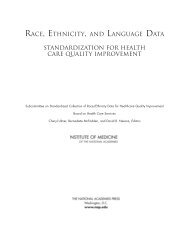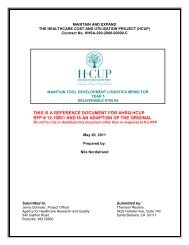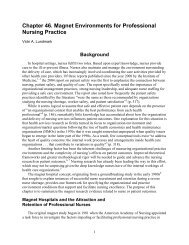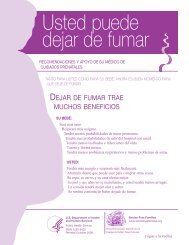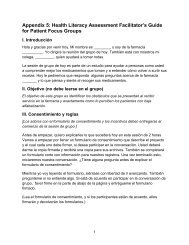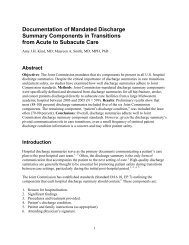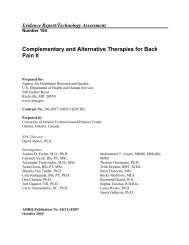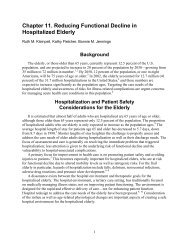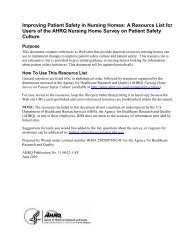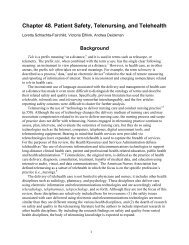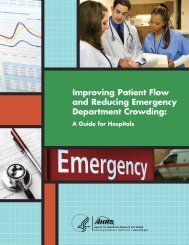Stories of Success: Using CUSP To Improve Safety - Agency for ...
Stories of Success: Using CUSP To Improve Safety - Agency for ...
Stories of Success: Using CUSP To Improve Safety - Agency for ...
You also want an ePaper? Increase the reach of your titles
YUMPU automatically turns print PDFs into web optimized ePapers that Google loves.
context <strong>of</strong> a hospital environment at a unit level. With the addition <strong>of</strong> <strong>CUSP</strong> tools, the technical<br />
intervention was readily accepted due to the culture change that <strong>CUSP</strong> promotes.<br />
How <strong>To</strong> Learn More About <strong>CUSP</strong> With the <strong>CUSP</strong><br />
<strong>To</strong>olkit<br />
In September 2012, AHRQ released the <strong>CUSP</strong> <strong>To</strong>olkit, a science-based “change package” that<br />
helps hospital teams understand how to identify safety problems and gives them tools to tackle<br />
these problems. The toolkit is applicable to all hospital staff—unit managers; quality, patient<br />
safety and infection prevention <strong>of</strong>ficers; and senior leaders. Created by clinicians <strong>for</strong> clinicians,<br />
the toolkit is modular and modifiable to meet individual unit needs. The teaching tools and<br />
resources support change at the unit level, with step-by-step instructor guides, slides and<br />
presentation materials, implementation tools such as checklists, and videos that simulate desired<br />
behaviors. The <strong>CUSP</strong> <strong>To</strong>olkit is enhanced with additional patient safety resources such as<br />
TeamSTEPPS ® , Just Culture, and Sensemaking, a deliberate process <strong>of</strong> reflection on defects,<br />
failures and near misses. The <strong>CUSP</strong> <strong>To</strong>olkit contains the following nine modules:<br />
• Learn About <strong>CUSP</strong><br />
• Assemble the Team<br />
• Engage the Senior Executive<br />
• Understand the Science <strong>of</strong> <strong>Safety</strong><br />
• Identify Defects Through Sensemaking<br />
• Implement Teamwork & Communication<br />
• Apply <strong>CUSP</strong><br />
• The Role <strong>of</strong> the Nurse Manager<br />
• Spread<br />
The <strong>CUSP</strong> <strong>To</strong>olkit is available at www.ahrq.gov/pr<strong>of</strong>essionals/education/curriculumtools/cusptoolkit.<br />
The <strong>CUSP</strong> model has proved its worth in preventing HAIs, and hospitals are successfully using<br />
<strong>CUSP</strong> to address multiple patient safety concerns, such as falls and pressure ulcers. The <strong>CUSP</strong><br />
<strong>To</strong>olkit is an important resource to empower unit teams, supported by engaged leadership, to<br />
improve safety culture and thereby save lives and resources.<br />
Peterson Regional Medical Center<br />
Peterson Regional Medical Center’s CEO Pat Murray came back from a Texas Hospital<br />
Association (THA) meeting in August 2010 intrigued by <strong>CUSP</strong>. He asked his Director <strong>of</strong> Quality<br />
Services how Peterson might best use the <strong>CUSP</strong> culture change model and explored potential<br />
projects with nursing leadership. Consensus converged around CLABSI. Theresa Hickman, RN,<br />
an ICU nurse, manager, and educator, was asked to lead its implementation because <strong>of</strong> her prior<br />
<strong>CUSP</strong> experience at another facility, her communication skills, and her passion <strong>for</strong> <strong>CUSP</strong>:<br />
“The <strong>CUSP</strong> program is the most powerful thing that has ever come into health care. It has<br />
the most potential to do good <strong>for</strong> patients. It’s not just the CLABSI, it’s the culture work,<br />
getting doctors and nurses to collaborate with each other, allowing nurses to identify and<br />
6



